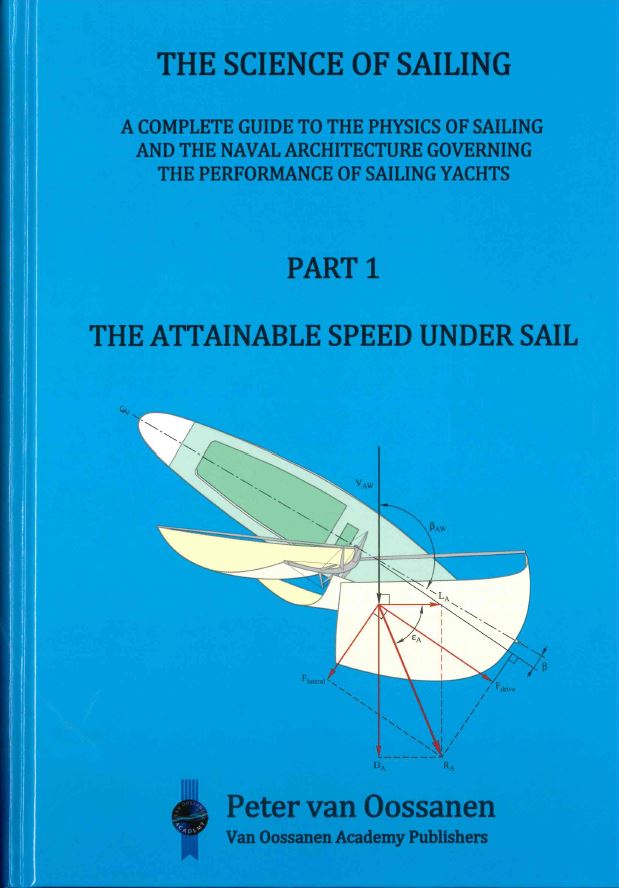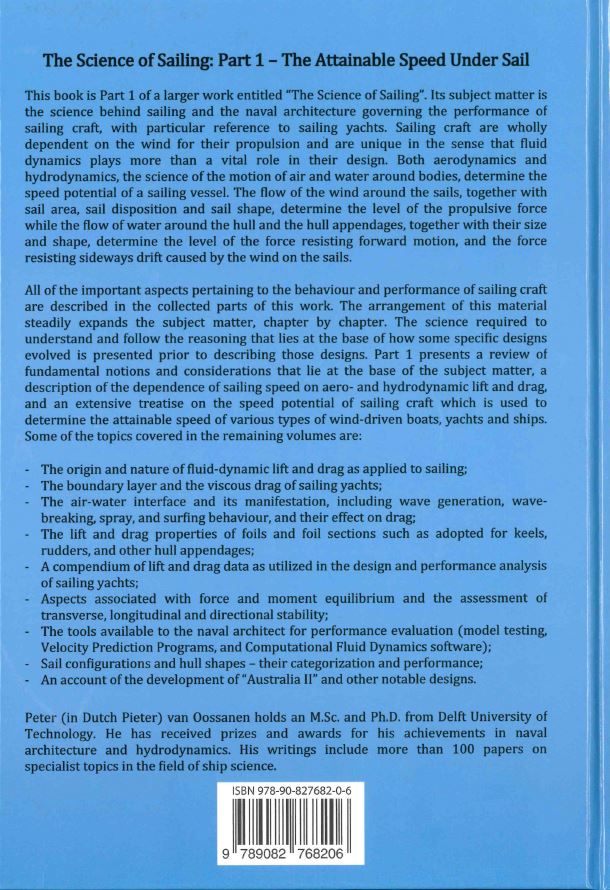Inspiration
(note from Peter)
I retired as CEO of the Van Oossanen group of companies on January 1, 2013. I had decided many years before that I would write a book on ‘The Science of Sailing’ when I had the time to do so. The design and performance aspects of sailing craft (particularly high performance sailing yachts) had captured my interest as early as 1975 when I was employed by the Maritime Research Institute Netherlands (MARIN). My research work on International 12 Meter Class yachts, from 1975 through 1983, was to result in the winning of the America’s Cup by Australia. I was largely responsible for the design of the hull and the keel of the subject yacht. So, when I retired, I decided to embark on the writing of the book. On finding out that the subject matter I wanted to deal with covered more than a thousand pages, I decided to divide the material into separate themes allowing for publication of separate parts. This first part, with the sub-title ‘The Attainable Speed Under Sail’, was first published in 2018. It covers a number of introductory chapters to the following parts.
Chapter 1 is an introduction to the collected work. Chapter 2 provides a review of basic notions and considerations which readers with a formal training in naval architecture and in aero- and hydrodynamics, may skip over. This chapter describes, first of all, the scientific method which lies at the base of all science since the days of Isaac Newton. The nature of mathematical formulae and how these are typically derived is then addressed, followed by a summary of the basic mathematical functions utilized to form such formulae. The building of mathematical models and algorithms is described, followed by a portrayal of the physical quantities we work with – their dimension, and the units we have given to them. The concept and use of non-dimensional coefficients and numbers is reviewed, and a description is given of the properties of air and water – the two mediums in which a sailing vessel, at the interface between the two, operates. Chapters 3 and 4 provide a description of the basic speed-producing factors for sailing craft that can be derived from setting the resultant aerodynamic force equal and opposite to the resultant hydrodynamic force. Some important conclusions can be derived from this basic equilibrium condition and these two chapters present these, utilizing some assumptions which, in later chapters, are further validated. The mathematical treatment of Chapter 4 is particularly developed for the purpose of showing the degree to which the speed of wind-driven craft is dependent on the aerodynamic lift and drag forces acting on the above-water parts of the vessel and the hydrodynamic lift and drag forces acting on the below-water hull and appendages. This chapter “sets the scene” for the following chapters that deal with the many aspects of fluid-dynamic lift and drag.

Blurb text
This book is Part 1 of a larger work entitled ‘The Science of Sailing’. Its subject matter is the science behind sailing and the naval architecture governing the performance of sailing craft, with particular reference to sailing yachts. Sailing craft are wholly dependent on the wind for their propulsion and are unique in the sense that fluid dynamics plays more than a vital role in their design. Both aerodynamics and hydrodynamics, the science of the motion of air and water around bodies, determine the speed potential of a sailing vessel. The flow of the wind around the sails, together with sail area, sail disposition and sail shape, determine the level of the propulsive force while the flow of water around the hull and the hull appendages, together with their size and shape, determine the level of the force resisting forward motion, and the force resisting sideways drift caused by the wind on the sails.
All of the important aspects pertaining to the behaviour and performance of sailing craft are described in the collected parts of this work. The arrangement of this material steadily expands the subject matter, chapter by chapter. The science required to understand and follow the reasoning that lies at the base of how some specific designs evolved is presented prior to describing those designs. Part 1, entitled ‘The Attainable Speed Under Sail’, presents a review of fundamental notions and considerations that lie at the base of the subject matter, a description of the dependence of sailing speed on aero- and hydrodynamic lift and drag, and an extensive treatise on the speed potential of sailing craft which is used to determine the attainable speed of various types of wind-driven boats, yachts and ships. Some of the topics covered in the remaining volumes are:
- The origin and nature of fluid-dynamic lift and drag as applied to sailing (Part 2);
- The boundary layer and the viscous drag of sailing yachts (Part 3);
- The air-water interface and its manifestation, including wave generation, wave-breaking, spray, and surfing behaviour, and their effect on drag (Part 4);
- The lift and drag properties of foils and foil sections such as adopted for keels, rudders, and other hull appendages (Part 5);
- A compendium of lift and drag data as utilized in the design and performance analysis of sailing yachts (Part 6);
- Aspects associated with force and moment equilibrium and the assessment of transverse, longitudinal and directional stability (Part 7);
- The tools available to the naval architect for performance evaluation (model testing, Velocity Prediction Programs, and Computational Fluid Dynamics software) – Part 8;
- Sail configurations and hull shapes – their categorization and performance, including an account of the development of “Australia II” and other notable designs (Part 9).
Peter (in Dutch Pieter) van Oossanen holds an M.Sc. and Ph.D. from Delft University of Technology. He has received prizes and awards for his achievements in naval architecture and hydrodynamics. His writings include more than 100 papers on specialist topics in the field of ship science.

Purchase information
The book is published by Van Oossanen Academy Publishers, and produced by Buijten & Schipperheijn b.v. in Amsterdam. It has a hard cover. The book comprises 214 pages. Its ISBN number is 978-90-827682-0-6. The book is sold by all major bookshops. It can also be ordered directly from Van Oossanen Academy Publishers. The following link is provided for that purpose.